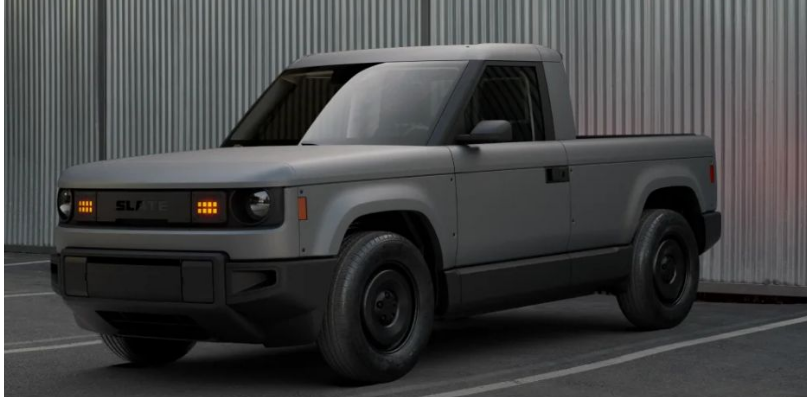Introduction Slate Truck Price : What Happened to Slate Truck’s $20K Promise?
When Slate Motors announced its sub-$20,000 electric truck, it promised to democratize EV ownership in the U.S. with affordability, performance, and sustainability packed into a sleek urban hauler. The internet erupted in excitement.
But by mid-2025, the dream has become yet another political casualty.
What once stood as a symbol of progress is now bogged down in bureaucracy, trade wars, and shifting regulations.
This post explores how the Slate Truck price collapsed under the weight of politics—and what it means for everyday American drivers.

A Quick Overview of Slate EV Truck
Slate Motors’ compact electric truck targeted first-time EV buyers, urban delivery services, and budget-conscious households. Marketed with:
- Sub-$20,000 MSRP
- 200+ mile range
- Fast-charging capability
- Compact, modular design
It quickly became one of the most anticipated electric vehicles of 2024–2025.
1. Policy Shifts and EV Tax Credit Confusion
The Inflation Reduction Act initially gave hope to small EV startups like Slate by offering federal tax credits up to $7,500. However, updated eligibility rules excluded many vehicles due to battery sourcing and final assembly requirements.
As a result:
- Slate lost access to federal incentives, raising the effective price for buyers.
- Confused buyers backed out of pre-orders.
- Dealers couldn’t guarantee eligibility at point-of-sale.
According to Whitehouse.gov (DoFollow), stringent local content rules and yearly changes to eligibility have made planning nearly impossible for smaller automakers.
2. Tariffs and Supply Chain Tensions
In Q1 2025, the U.S. government introduced new tariffs on Chinese EV components—especially batteries and electronics.
Slate, which sourced 30–40% of its electronics and battery components from China, was hit hard. The tariffs added $2,500–$4,000 per unit, effectively killing their $19,995 price tag.
This change highlights the fragile balance between affordability and geopolitical strategy—making Slate Truck price volatility a cautionary tale.
3. Political Backlash on Foreign Components
Senators and lobbyists began pushing a narrative that low-cost EVs sourced from non-U.S. manufacturers threatened American jobs.
Slate, despite assembling trucks in Nevada, faced scrutiny for:
- Chinese-sourced battery cells
- Korean infotainment systems
- Taiwanese semiconductor reliance
Public pressure led to delays in EPA certifications, congressional hearings, and investor anxiety.
4. State-Level EV Restrictions
While some states like California encouraged EV growth, others introduced tighter restrictions on non-domestically built electric vehicles.
For example:
- Texas revoked state EV tax credits for any vehicle with foreign-majority parts.
- Florida introduced sales caps on non-domestically assembled trucks.
Slate’s rollout was stunted in more than 11 states, further undermining their price advantage and accessibility.
5. Inflation, Lobbying, and Corporate Pressure
Legacy automakers lobbied against ultra-cheap EV startups, citing “unfair competition.” Meanwhile, rising inflation drove up:
- Labor costs
- Lithium prices
- Transportation and warehousing fees
These pressures—combined with limited access to capital—forced Slate to raise its MSRP to $26,750 by July 2025.
Key Specifications of Slate Truck
| Specification | Original Plan | Final Specs (Post-2025) |
|---|---|---|
| Starting MSRP | $19,995 | $26,750+ |
| Range | 210 miles | 220 miles |
| Battery Pack | 45 kWh | 48 kWh |
| Drive Type | RWD | RWD / AWD (Optional) |
| Fast Charging (10–80%) | 30 minutes | 28 minutes |
| Towing Capacity | 2,000 lbs | 2,500 lbs |
Top Features: Tech, Design & Sustainability
Despite the pricing setback, Slate still offers industry-leading features:
- AI-powered route optimization
- Removable tailgate for extended cargo
- Full solar-roof integration for trickle charging
- Recycled aluminum and vegan interior materials
- OTA updates and full mobile control
Slate’s sustainability efforts remain strong—but they now come at a higher cost.
FAQs
Q1: Is the Slate Truck still available for under $20,000?
No. Due to tariffs, policy changes, and rising costs, its price is now $26,750+ in most regions.
Q2: Can buyers still qualify for federal tax credits?
Only in limited cases, based on assembly and component origin. Most Slate models are not eligible in 2025.
Q3: Will Slate return with a cheaper model later?
The company hinted at a future subcompact model in 2026, but pricing will depend on future policy shifts.
Q4: Is the Slate Truck still worth buying?
If you’re looking for a compact EV truck with tech, durability, and green features—yes. But the low-cost edge is gone.
Final Thoughts
The Slate Truck price saga tells a bigger story: one of policy, innovation, and broken promises. While the dream of an affordable electric truck captivated the public, political realities ultimately reshaped its fate.
Until there’s bipartisan alignment on EV strategy, innovative startups like Slate will struggle to compete, and U.S. drivers will continue to pay the price.
